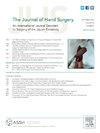Quantifying the Burden of Unmet Upper Extremity Care Need in Low-Middle Income Countries: A Four-Country, Cluster-Randomized Study
IF 2.1
2区 医学
Q2 ORTHOPEDICS
引用次数: 0
Abstract
Purpose
Currently, no nationally implementable survey exists to identify the burden of hand and upper extremity conditions at the household level in low-middle income countries (LMICs). This study describes a randomized cluster survey approach to estimating the burden of hand and upper extremity conditions in four LMICs using the Surgeons OverSeas Assessment of Surgical Need (SOSAS) survey. Additionally, this study identifies factors associated with responses of unmet surgical need at the multinational level.
Methods
The SOSAS instrument is a cluster-randomized, cross-sectional, countrywide survey of households administered in Nepal, Rwanda, Sierra Leone, and Uganda from 2011 to 2014. We identified nationwide trends for sociodemographic, anatomic, condition type, mechanism, prevalence, subjective disability, and barriers to care for upper extremity survey responses. A multivariable model identified factors associated with unmet upper extremity need across the four nations.
Results
Across the four countries, 13,763 individuals participated in the survey, with 883 conditions of the upper extremity identified (7.4% of all surgical conditions surveyed). Fractures accompanied many of the injuries (32.3%). Although most conditions were acquired, congenital conditions comprised 11% of all etiologies. Overall, open fire/explosion was the most common mechanism (22.9%). Rwandans had the highest proportion of individuals seeking care (91.0%) and receiving care (88.6%). Sierra Leone indicated the fewest seeking and receiving care (71% and 63%, respectively). Chronic injuries were significantly associated with receiving care, whereas illiteracy and worsening subjective disability were barriers to receiving care.
Conclusions
In this survey of upper extremity conditions from four LMICs, upper extremity conditions primarily resulted from fire/explosions, and many reported sustaining a fracture. Illiteracy and more disabling conditions decreased the odds of receiving care by 30% to 40%, respectively.
Clinical relevance
The SOSAS survey may provide a reproducible means to evaluate the unmet need for upper extremity care across similar LMICs.
量化中低收入国家未得到满足的上肢护理需求的负担:四国分组随机研究》。
目的:目前,在中低收入国家(LMICs)还没有一项可在全国范围内实施的调查来确定家庭层面的手部和上肢疾病负担。本研究介绍了一种随机分组调查方法,利用海外外科医生手术需求评估(SOSAS)调查来估算四个中低收入国家的手部和上肢疾病负担。此外,该研究还确定了在多国层面上与未满足手术需求的反应相关的因素:SOSAS调查工具是2011年至2014年在尼泊尔、卢旺达、塞拉利昂和乌干达进行的一项分组随机、横断面、全国性家庭调查。我们确定了全国范围内社会人口、解剖、病症类型、机制、患病率、主观残疾以及上肢调查回复的护理障碍等方面的趋势。一个多变量模型确定了四个国家上肢需求未得到满足的相关因素:四个国家共有 13,763 人参与了调查,共发现 883 种上肢疾病(占调查的所有外科疾病的 7.4%)。许多损伤都伴有骨折(32.3%)。虽然大多数情况都是后天造成的,但先天性情况占所有病因的 11%。总的来说,明火/爆炸是最常见的致伤原因(22.9%)。卢旺达人寻求医疗服务(91.0%)和接受医疗服务(88.6%)的比例最高。塞拉利昂人寻求治疗和接受治疗的比例最低(分别为 71% 和 63%)。慢性损伤与接受治疗密切相关,而文盲和主观残疾恶化则是接受治疗的障碍:在对四个低收入和中等收入国家进行的上肢伤病调查中,上肢伤病主要是由火灾/爆炸造成的,许多人还报告了骨折。文盲和致残率较高的病症使接受治疗的几率分别降低了30%到40%:SOSAS调查可提供一种可重复的方法,用于评估类似低收入国家和地区未得到满足的上肢护理需求。
本文章由计算机程序翻译,如有差异,请以英文原文为准。
求助全文
约1分钟内获得全文
求助全文
来源期刊
CiteScore
3.20
自引率
10.50%
发文量
402
审稿时长
12 weeks
期刊介绍:
The Journal of Hand Surgery publishes original, peer-reviewed articles related to the pathophysiology, diagnosis, and treatment of diseases and conditions of the upper extremity; these include both clinical and basic science studies, along with case reports. Special features include Review Articles (including Current Concepts and The Hand Surgery Landscape), Reviews of Books and Media, and Letters to the Editor.

 求助内容:
求助内容: 应助结果提醒方式:
应助结果提醒方式:


